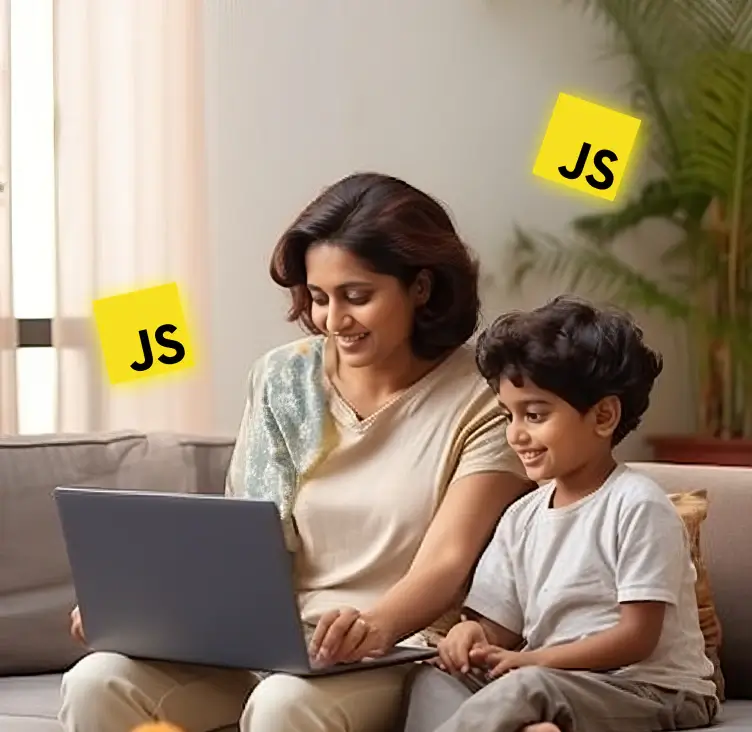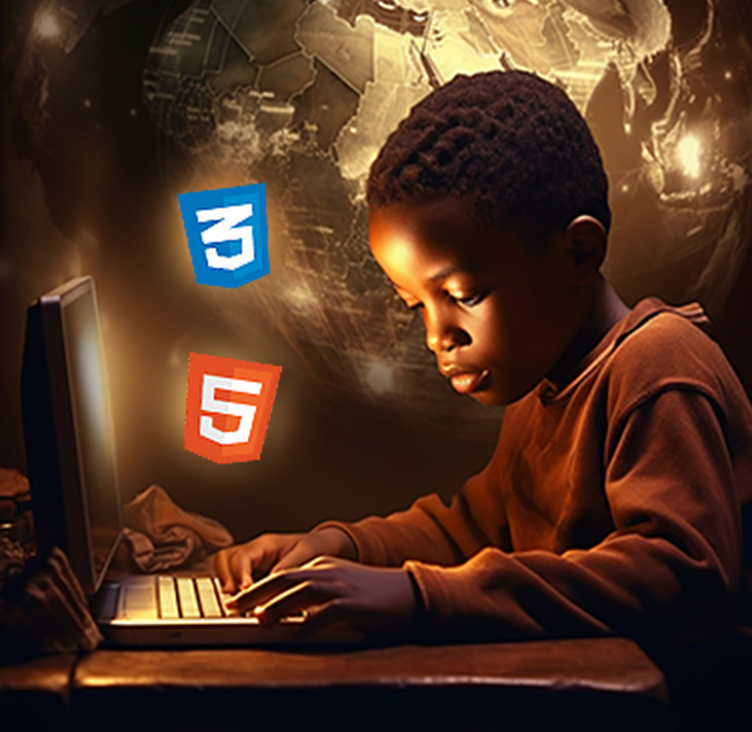Imagine your kid’s gaming addiction is converted into a future-ready skill that would help in their academics, improve their analytical abilities, and act as a good exercise for the brain while being fun and engaging. Will you encourage your child to learn the skill?
If yes, game development for kids is a savior for you. If you are a parent, you must be bothered by your kid’s extreme gaming habits. Game development is a magical world that has the capability of turning a player into a developer at a young age. Game development is one of the fastest expanding fields with a plethora of job opportunities.
Game development is an excellent add-on to a kid’s education as it allows kids to develop critical, analytical, and profound thinking abilities. It allows them to explore their creative side and make their limitless potential a reality. So, if you are ready to make your child a brilliant game developer from a simple gamer, this blog will help you know everything about game development for kids and the steps involved in it.
Understanding Game Development: A Simple Overview

Game development is the process of envisioning, designing, developing, and introducing challenges, players, and other fun elements to build a game that engages the players in a virtual world. In layman’s terms, game development involves creating an engaging set of fun challenges for the players to interact with. So what makes the games so addictive? Well, one must craft numerous fun elements to make the video game immersive, interactive, and engaging.
For game development, the developer needs to include the following elements:
Compelling Story: A compelling story will make the players emotionally invested in the game. A good story, complete with choices, twists, and new challenges, will engage players like nothing else.
Irresistible Challenges: Challenges hook the players. New and better challenges will make players return to the game and play longer to complete them.
Engaging Graphics and Design: Immersive graphics and a well-designed game will be a visual treat to the players and enrich the gaming experience exponentially.
Fun Player Avatars: Cooler player avatars are key elements of a good game. Good characters in a game make the gameplay interesting with their powers, perks, and characteristics.
Coveted Rewards: Crafting a reward system that makes the players want to win and show off will take the game to new heights. Consistent rewards will also instill a sense of accomplishment in the players, making them more connected to the game.
User-friendly mechanics and controls: The game has to be user-friendly, with well-placed controls, and smooth, bug-free gameplay. Better mechanics and a clutter-free environment will offer a seamless gameplay experience.
A good game is what gets the player emotionally invested. So, a good sound design, a clean UI, and the ability to share and experience the game with peers also contribute to a game becoming popular and engaging. If you notice all the games that your kids play, you’ll know.
Why Should Your Child Learn Game Development?

Your little one is at the pinnacle of their learning capabilities from ages 5-15. They are innately curious and ready to absorb information like sponges. There are so many advantages of coding for kids, and game development requires coding.
Game development isn’t just an activity to engage your kids. Imagine a world where kids are creative wizards, tech heroes, and problem-solving champs—all because they learned the magic of game development!
Here are some of the reasons why kids should learn game development:
- Fostering Creativity: Game development encourages kids to transform their creative ideas into realities. It’s like having a giant box of colorful LEGO bricks. Kids can build their own worlds, characters, and stories, letting their imaginations run wild.
- Makes them Academically Sound: Game development requires good mathematical and logical abilities to form a functional code to run the game. So, if you want to arm the kids with at-par STEM (Science, Technology, Engineering and Mathmatics) skills, game development will do that for you. In turn, they score extra points in their academics.
- Building Problem-Solving Skills: Creating a game involves overcoming a series of challenges. Kids learn to tackle problems, find solutions, and work on their creations through iterative design. This process hones their problem-solving skills.
- Preparing for the Future: Game development introduces children to essential future skills like coding, design principles, and project management. As a kid, imagine learning skills that can help you do cool things with computers when you grow up!
- Improves Focus and attention to detail: Making games is like playing detective. You need to pay attention to the tiniest details to ensure everything is running smoothly. This intensified their focus, which is helpful for their academics as well.
- Feeling of Accomplishment: Game development provides the kids with much-needed confidence and a feeling of accomplishment when they create an entire game based on their own knowledge and understanding. It gives a boost to their self-esteem and pushes them to create and explore more.
- Encourages Critical thinking: Creating a game makes the kids naturally curious about the mechanisms of their favorite games. They start to see the games from a more critical point-of-view, paying attention to the graphics, movements, logic, etc. This pushes them to develop high-level critical thinking skills.
- Makes them Techno-Savvy: Game development makes children comfortable with the latest tech. They learn to do epic stuff when they get super skilled with computers and tech, which is like having a superpower in today’s world.
Overall, game development is an activity that targets multiple skills at once. It teaches communication, collaboration, and teamwork. Kids learn to multitask, think logically, and become naturally curious to explore the mechanisms behind everything.
But how will they do all this at such a young age? Well, there are multiple kid-friendly tools to help them.
Kid-Friendly Tools to Help Game Development for Kids

When we say that kids can develop games, we mean it. There are so many kid-friendly tools that help kids develop games without performing stringent coding. Most of these tools have drag-and-drop functionality that allows kids to program through block-based coding. They can work with these tools until they are ready to work with advanced game development tools like Unity, JAVA, Godot, etc.
Some of the game development tools for kids are:
- Scratch: Kids need to play to relate to their surroundings and learn. Scratch is like a digital playground where kids can create games, animations, and interactive stories using colorful blocks. MIT designed it to be super friendly and easy for kids to understand coding concepts without getting overwhelmed. With drag-and-drop blocks, kids can build characters, add movement, and make things happen, all while having tons of fun!
- Coda Game: Coda Game is another exciting platform that allows kids to design their own games without any coding experience. It’s all about using visual elements to create games, step by step. From crafting characters to setting up gameplay rules, Coda Game helps kids unleash their creativity and see their ideas come to life. It’s a game to develop game.
- Minecraft EDU: If you have played Minecraft, you know that Minecraft EDU will be an ideal place for your kids to learn and perform coding. It turns the popular game of building and exploring into an educational adventure. Kids can learn coding by creating mods- little programs that add new features to the game. They can design their own blocks, creatures, and even behaviors, adding a whole new layer of creativity to the Minecraft experience.
- Tynker: Tynker is like a dedicated coding platform designed just for kids. It allows kids to create everything from games to apps. Through interactive coding lessons and puzzles, it allows kids to learn coding in a playful way. Kids can also create games and animations using Tynker’s user-friendly interface.
- Roblox Studio: Roblox Studio is a creative studio where kids can design their own games and experiences within the Roblox platform. It’s especially suitable for those who love playing Roblox and want to take their creativity to the next level. With Roblux Studios, kids can build worlds, characters, and gameplay controls, and even share their creations with the Roblox community.
These tools are a gift for young kids who want to kickstart their journey as game developers. There are other gamified coding platforms like HackerKID, through which you can teach your kids the basics of coding and game development through a block-based interface. Once they get the hang of coding for games, it will become very easy and intriguing for kids to start coding their desired elements for the game.
How to Start Game Development for Kids

With the perfect tools to start, it’s time to get started with game development. There are multiple fun processes that we have to work on when it comes to designing and building a game from scratch.
Here are the key steps that kids must complete to develop a game:
Step 1: Ideation: Let the imagination and creativity run wild
Imagine this step as your child’s amazing daydreams coming to life! Game development lets them turn their whacky ideas into virtual worlds. It’s all about using their imagination to create the foundation of their game.
Encourage your child to draw inspiration from their favorite stories or invent entirely new adventures. Let them create a storyline with a key mission, a main conflict, and interesting twists. They can create engaging characters to which people can relate and get attached. The possibilities are endless!
Step 2: Creation: Drawing and Designing a World and its Characters
Think of this step as if your child is a super creative artist. They get to draw characters, scenes, and everything else that makes the game look awesome. They’ll use their skills to give life to their game’s heroes, villains, and the places they’ll explore.
Let them delve into character creation and design. Visualizing their ideas through art brings their creations to life. They can draw inspiration from their favourite cartoon characters or movies.
Step 3: Simple Coding: Make the Games Move
Coding is like giving the game its superpowers! But don’t worry, it’s not as hard as it sounds. Think of it as building with LEGO bricks. As discussed above, there are numerous block-based coding environments and tools that help kids code and animate their creations with a drag-and-drop interface.
As your child puts together different blocks, they can make characters move, have objects interact, and even create special effects, all by dragging and dropping the right blocks in place. They can define the controls and the mechanisms to let players interact, engage, and control the game.
Step 4: Testing: Evaluating the Creation and Refining Accordingly
This step is like your child’s game getting a check-up. They get to play their own game and see how it feels. It’s super fun because they’re the first ones to try it out! If something doesn’t work or requires improvement, they can go back and make changes until it’s just right. Putting the game through various tests and trials critically is an important part of game development.
This is the step that will help them become a developer from a player. It’s like tweaking a recipe until it tastes perfect. Your child gets to experience a sudden confidence boost and ecstasy when they play their own creation. Through testing and tweaking, they refine their game for optimal fun.
Step 5: Sharing the Joy: Letting Friends and Family Join the Fun
Imagine your child throwing a big party and inviting everyone to play their game! They get to share all the fun they’ve created with friends and family. It’s like showing off their masterpiece. Everyone can play the game and have a blast. Plus, your child will feel proud and happy to see others enjoy what they’ve made. Extend the excitement by allowing friends and family to experience their creations. Sharing their games fosters a sense of accomplishment and pride.
From the above processes, we can ascertain that game development is like solving a puzzle. We bring all the pieces together to reveal the main picture. It’s like a game for kids. The only difference is that the challenge is to build the game by completing various levels and missions. Sounds fun, right?
Many young kids have achieved the feat. Let’s learn from their journey.
How to Support Your Child’s Game Development Passion

Kids need encouragement and validation from their parents to face any challenge or start a new journey. There are various genres of games like arcade, puzzle, simulation, story-based, etc. Understand your kid’s interest and then direct them to develop a game in that genre. Your guidance and support can go a long way toward making your child believe in their abilities and gain the required skills.
As parents, here are a few ways you can support your kid’s passion for game development:
1. Encouragement: You need to nurture their interest by acknowledging their achievements and providing positive feedback. Show them that you believe in them.
2. Learning Resources: Keep exploring recommended courses and books specially designed for young developers. Direct your kids to these resources and help them use them optimally.
- You can get your kid enrolled in various summer camps, workshops, or online game development courses to teach them game development in a kid-friendly fashion. You can check out various ed-tech platforms like HackerKID, Code.org, etc. that offer coding courses for kids.
- There are various learning apps or game development coding games that help teach coding to kids, which will help them get the hang of basic coding and push them forward in their game development journey. The Infinite Arcade, Tiny Tap, Gamestar Mechanic, Unruly Splats, Gamefroot, etc. are a few notable game development games that are instrumental in teaching kids.
- The best part about game development is that the internet has valuable websites and helpful developer communities that provide great advice and resources for potential learners. There are literally so many YouTube channels that teach game development to kids in an easy and interesting way!
3. Communities:You would not know everything. Yet, you can always learn stuff from those who know. Try connecting through online coding communities for young kids and parents. Sharing experiences and seeking advice can fuel their enthusiasm.
4. Balanced Screen Time: While game development is exciting, you’ll have to ensure a healthy balance between screen time and other activities.
5. Innovation Freedom: The process of game development can be longer and tedious. You have to allow room for experimentation, mistakes, and disappointments so that your child can learn while having fun, without the pressure of expectations and frustration.
6. Be an example: There’s no age bar when it comes to learning. Try learning a few basics of game development yourself or with them. This will make the kids more excited and readily involved with the learning process.
Before introducing game development to your kids, make sure they are actually into gaming. If not, you can try to induce curiosity by asking them to look into the creative process of their favorite game. Once they show an interest in learning about the architecture of games, you can introduce game development to your kids according to their age.
Are You Ready for a Tech Challenge?
Skip the ordinary and jump into Buzzer, the interactive MCQ game designed for kids who love computer science and technology! Pick a topic, hit the buzzer, and test your knowledge with thrilling gamified questions. Stay sharp, score high, and claim your spot at the top! Play Buzzer now!
Conclusion
Game development is an extremely beneficial and fulfilling process that provides a sense of purpose to your kids while giving you the assurance of a productive activity for your kids. You can really witness your child evolve and achieve their full potential. Just give them the tools, a little nudge in the right direction is all they need to get started.
You will actually start loving the field of gaming once you see how your kid’s love for gaming is helping them achieve academic excellence, creative freedom, and a natural instinct to think logically and critically. This is your chance to take your kids on a journey of exceptional exploration. Let their gamer side interact with their potential developer side and watch the magic unfold.
Get your kid enrolled in HackerKID’s exclusive course in game development, a comprehensive game development course specially designed for kids. Let the learning with fun begin!
FAQs
Is game development hard for kids?
Game development for kids seems like a difficult thing to learn, but it isn’t. Game development is really easy to learn if the child is interested in the gaming world. Their natural curiosity and involvement with the games serve as a good base for their game development journey. From there onwards, kids can easily learn and work on game development through various kid-friendly tools and platforms.
When should kids start learning game development?
Kids can start learning game development at the age of 5-7 in an age-appropriate manner. Young kids can play mini-games or practice playing logic-building games before moving on to specific game development platforms where they can code the games. Parents can make them aware of the building process of their favourite games before they get their game development journey started.
How to teach game development to kids?
HackerKID’s exclusive game development course for kids is one of the best ways to teach game development to kids. The platform offers one-on-one mentorship classes, a dedicated gamified platform to learn and practice coding, and hands-on projects with certification.
Additionally, there are numerous YouTube channels, websites, and online communities that provide good quality learning videos, tips, and tricks for kids. You can also enroll your child in various coding summer camps or workshops that teach game development for kids.










